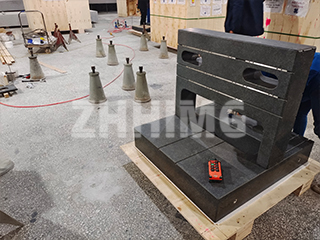When selecting precision measurement tools for industrial use, choosing the right material is crucial. Granite and marble are two commonly used materials for mechanical components, each offering unique advantages. Understanding the differences between granite and marble mechanical components will help you select the best option for your precision measurement needs.
What is Marble?
Marble, originally referring to the white limestone with black patterns from Dali, Yunnan Province, is a metamorphic rock commonly used in decorative architecture. In ancient times, high-quality marble was often used for creating artwork, screens, or mosaic designs. Over time, the term “marble” has come to represent any limestone used in architecture, with white marble often referred to as “Han Baiyu” (Chinese white marble).
What is Granite?
Granite is an acidic (SiO2>66%) intrusive igneous rock, commonly found in a variety of colors such as light red, light gray, and off-white. It is known for its coarse to medium-grain structure and strong, durable properties. As one of the most common rocks in the Earth’s crust, granite is highly valued for its stability, hardness, and resistance to wear.
Granite vs. Marble Mechanical Components: Key Differences
1. Material Properties and Precision:
-
Granite Mechanical Components:
Granite components are highly durable, resistant to wear, and able to withstand high temperatures without deforming. They maintain precise measurements over time, making them ideal for high-precision industrial applications. Granite’s fine structure and low coefficient of thermal expansion contribute to its ability to retain accuracy under changing environmental conditions. -
Marble Mechanical Components:
Marble, on the other hand, is less durable than granite. It is more prone to wear and may not perform well in high-temperature or heavy-load environments. While marble can offer smooth surfaces for measurement, it is not as stable as granite in terms of maintaining long-term accuracy.
2. Precision and Accuracy Levels:
-
Granite Components:
Granite is available in several grades of precision, such as 000, 00, and 0. The 000 grade represents the highest level of precision, making granite ideal for applications that require extreme accuracy. Granite components offer high dimensional stability, low thermal expansion, and minimal deformation. -
Marble Components:
Marble components are typically less precise compared to granite. Due to its softer nature, marble may suffer from slight deformation under heavy use, leading to reduced accuracy over time.
3. Specifications and Size:
-
Granite:
Granite components are highly customizable in terms of size, and the weight of granite plates can be quite substantial. Due to its density and stability, larger granite platforms are used for heavy-duty industrial applications where precision is critical. Granite is available in large sizes and can meet more demanding specifications. -
Marble:
Marble components, while also available in large sizes, are generally lighter and more suitable for applications with less rigorous demands. The size of marble plates will directly influence the cost and transport expenses, as marble is less dense than granite.
4. Durability and Maintenance:
-
Granite Mechanical Components:
Granite is highly resistant to wear, corrosion, rust, and high temperatures, ensuring long-lasting performance. Its hardness and resistance to deformation make it suitable for demanding environments where accuracy is critical. Additionally, granite requires minimal maintenance, does not require oiling, and is resistant to magnetic interference. -
Marble Mechanical Components:
Marble requires more careful maintenance compared to granite. It is more susceptible to scratching, chipping, and surface damage, especially under heavy or high-temperature conditions.
5. Suitability for High-Precision Measurements:
-
Granite:
Granite’s fine-grain structure, hardness, and low thermal expansion make it the preferred material for high-precision measurement tools. Its ability to maintain accuracy in harsh conditions—such as changes in temperature or heavy mechanical loads—makes granite ideal for applications in fields like aerospace, automotive, and precision engineering. -
Marble:
Marble is not as suitable for high-precision measurements, especially in environments that require high durability or resistance to temperature fluctuations. While it can be used for less demanding applications, marble’s susceptibility to wear and tear limits its effectiveness for precision work.
Why Choose Granite for Your Mechanical Components?
Granite mechanical components are a top choice for industries requiring the highest precision. Their advantages include:
-
Superior Durability and Hardness: Granite components are resistant to corrosion, wear, and high temperatures.
-
Consistent Precision: Granite maintains its accuracy over time, even under heavy loads and varying environmental conditions.
-
Low Maintenance: Granite components require minimal care and do not need to be oiled or lubricated.
-
Stable Performance: Granite’s low coefficient of thermal expansion ensures that its dimensions remain stable, even in fluctuating temperatures.
Conclusion:
When choosing between granite and marble mechanical components, granite stands out as the material of choice for precision, durability, and long-term performance. While marble has its uses, especially in decorative and less demanding applications, granite is ideal for high-precision measurement tools that require stability, wear resistance, and minimal maintenance.
Post time: Aug-06-2025

